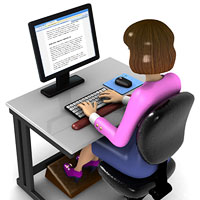

Most times this requires a desk which is 25 inches to 29 inches in height (depending upon size of individual) or the use of an articulating keyboard tray. To allow for proper alignment of your arms your keyboard should be approximately 1 inch to 2 inches above your thighs. There is no specific height recommended for your desktop however, the working height of your desk should be approximately elbow height for light duty desk work.

HEALTH AND SAFETY WITH COMPUTERS AT WORK PORTABLE
If you are like many computer users, your computer, keyboard, and mouse are resting on your desk or a portable computer workstation.
When armrests are used, elbows and lower arms should rest lightly so as not to cause circulatory or nerve problems. Adjust height and/or width of armrests so they allow the user to rest arms at their sides and relax/drop their shoulders while keyboarding. Back of knees should not come in direct contact with the edge of the seat pan (there should be 2-3 inches between the edge of the seat and the back of the knee). Thighs should be parallel to the floor and knees at about the same level as the hips. Sit upright in the chair with the low back against the backrest and the shoulders touching the backrest. Adjust height of chair so feet rest flat on floor (use footrest if necessary). The backrest angle is set so that your hip-torso angle is 90 degrees or greater. It may be useful to use a rolled towel or lumbar pad to support the lower back. Adjust height of backrest to support the natural inward curvature of the lower back. When performing daily tasks, alternate between sitting and standing. Don't stay in one static position for extended periods of time. The following recommendations can help increase comfort when using a computer: Gravity tends to pool blood in the legs and feet and create a sluggish return to the heart. Sitting for long periods of time can cause increased pressure on the intervertebral discs, the springy, shock-absorbing part of the spine. Complementary Safety Health and Wellness SupportĬontrary to popular belief, sitting, which most people believe is relaxing, is hard on the back. In Focus! Safe Workplaces For All Photo Contest. Healthcare Workers and Hospital Staff (Intranet Only). Design, Construction and Maintenance Workers. Employee Health Protection and Promotion. National Biosafety and Biocontainment Training Program. HHS Supervisor Training (Intranet Only). Occupational Safety and Health Committee. Portable High Efficiency Air Filtration Device Test Program. Safe Laboratory Practices and Procedures. Biological Materials Shipping (Imports/Exports). Unsafe or Unhealthful Conditions Reporting. Program Policy, Evaluations and Training. Your computer screen should be 20 to 24 inches from your eyes and the centre of the screen should be 10 to 15 degrees below your eye line. 
Improper posture while working on your computer can also add strain. Make sure your workstation and chair are at the correct height.Place documents on a copy stand next to the screen. Having to keep looking down at a piece of paper and then up at your monitor can contribute to eye strain.The way you sit at your desk and arrange your equipment can affect your vision. Blue light is short-wavelength visible light that is associated with more eye strain than longer-wavelength hues, such as orange and red. Adjust the monitor’s colour temperature to reduce the amount of blue colours on your screen.Black print on a white background is the best combination for comfort. Make sure the brightness is the same as the surroundings and adjust the text size and contrast so that it is comfortable to read.Adjusting your computer’s display settings can help reduce eye strain and fatigue.







 0 kommentar(er)
0 kommentar(er)
